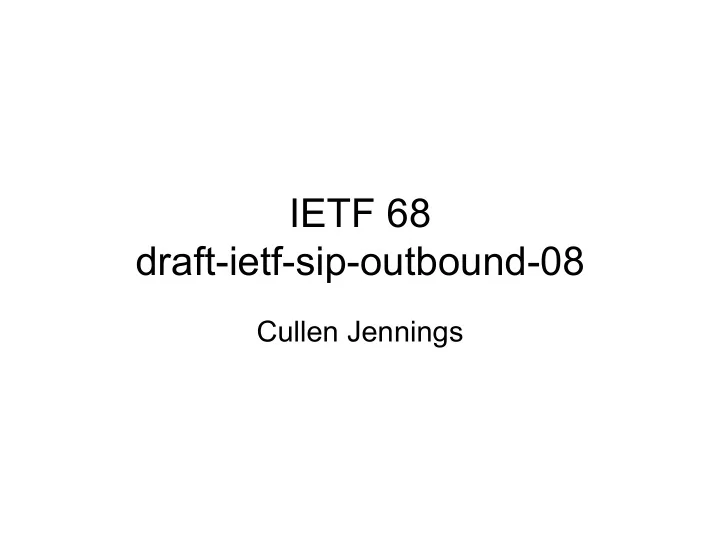

IETF 68 draft-ietf-sip-outbound-08 Cullen Jennings
The key point • We need to finish this document
Change from -07 to -08 • Some people on this list felt that we should use CRLF as the keep alive for TCP • Wrote text so that the WG could look at it and decide if this was the way they wanted to go – Added multiple keep alive mechanisms CRLF, STUN, TCP – Changed syntax of tags in URI to support this old: sip.example.com;keep-alive=stun new: sip:example.com;keep-crlf;keep-stun
Summary — The Good • Implementations that *only* do TCP, will not need to implement STUN • Implementations will not need to multiplex TCP and STUN
Summary — The Bad • You have to do RFC 3263 transport resolution *before* you know what keep alive scheme to use – Tricky if application does keepalive processing and SIP stack does DNS • If outbound URI says sip:example.com;keep- crlf but NAPTR ends up selecting UDP. – You have no resulting keepalive mechanism and outbound will not work • It is complicated to handle corner cases – Outbound proxy set says “use STUN”, but when you option probe for that proxy says “use CRLF”
Options • Option 1: Don’t do CRLF keep alive. Use text in (-07) version of draft. • Option 2: Keep text in this version (-08). • Recommendations – Cullen: Option 1 – Rohan: Option 2
When does the client have to do keepalives? • Sometimes the server expects keepalives to detect client liveness, sometimes it doesn’t • Sometimes the client doesn’t need/want aggressive keepalives. (ex: not behind a NAT and wants to minimize battery consumption) • Proposal: – ;keepalive-timer parameter in URI means that the server needs the client to send supported keepalives according to the timing described in the draft. – absence of the parameter means that the client gets to decide when/if to send keepalives (but no more frequently than in the draft). – no longer a need for ;keep-tcp parameter. The client can just do these if ;keepalive-timer is absent.
An Outbound Diet? Do we want to simplify this draft? • One type of instance ID (UUID) • One algorithm for flow tokens (the other one only works with SIPS) • The configuration of the URI indicates that you can do STUN. Incorrect configurations are considered an error, like sending SIP to the IMAP port • Drop advice about OPTION probing for stun (you could still do it if you wanted, just not discussed in spec) • In the current draft, if the flow works, then fails in the first 120 seconds, it is treated differently than after 120 seconds. Do we need this?
Recommend
More recommend